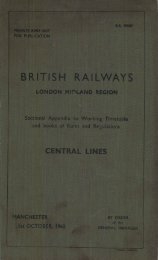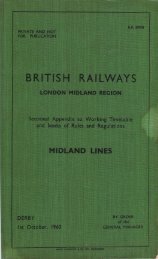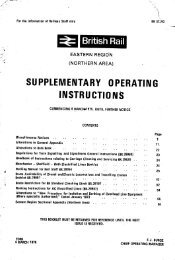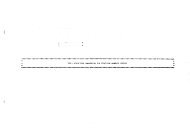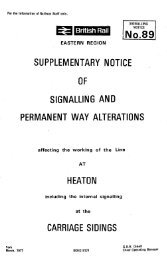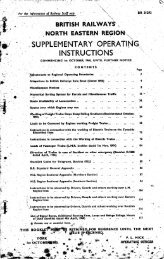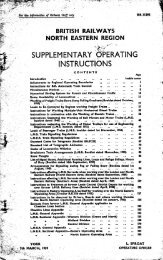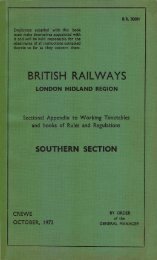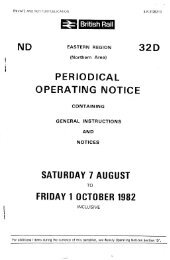general instructions. - Limit Of Shunt
general instructions. - Limit Of Shunt
general instructions. - Limit Of Shunt
Create successful ePaper yourself
Turn your PDF publications into a flip-book with our unique Google optimized e-Paper software.
130 G e n e r a l Instruction&—Continued.<br />
Working communication by means of Automatic Grake.—Continued.<br />
3.--(a) Should the driver, when working the Westinghouse brake, feel<br />
that the brake is being applied during the journey, he must put his handle<br />
over to " release " position and look back along the train, and if he finds<br />
that any of the discs on the carriages are in a vertical position, or hears a<br />
whistle sounding, or finds that the placing of his handle in " release" is<br />
controlling the application, this would indicate that the communication<br />
apparatus has been operated by a passenger. The driver must then bring<br />
his train to a stand as quickly as possible, having due regard to Rule 225<br />
in the Company's Book of Rules and Regulations.<br />
As the driver can control the application made by a passenger, except<br />
as mentioned in paragraph 9, trains should not be brought to a stand on<br />
an overbridge, or a viaduct, in a tunnel, on catch points, or any other place<br />
of a similar character, unless, in the opinion of the driver, there is urgent<br />
need for this to be done. ( B . 1575).<br />
(b) When the guard observes that the communication has been applied, he<br />
must act as circumstances require, and if he should have reason to believe<br />
that the communication chain has been pulled' but has not been noticed by<br />
the driver, he should take steps to stop the train by the application of the<br />
brake from his van, bearing in mind the instruction in paragraph 3 (a).<br />
The application by the guard must also be made in accordance with Westinghouse<br />
Rule 14, or Vacuum Rule 6, as the case may be.<br />
4.—When the train has been brought to a stand it must be protected as<br />
prescribed in the Regulations, and when it is not under the protection of<br />
fixed signals, and there is only one guard, the fireman must go back and<br />
protect the train whilst the guard attends to the requirements of the passenger<br />
who used the communication.<br />
5.—The guard must take steps to ascertain why, and by whom, the communication<br />
has been applied, and should the alarm have been mischievously<br />
given, or for an insufficient cause, the names and addresses of all passengers<br />
in the compartment must be taken, in order that the offending passenger<br />
may be properly dealt with.<br />
6.—The guard must, in addition to the notes on his journal, specially<br />
report any use that may have been made of the communication on the<br />
journey, or any failure in its action.<br />
7.—After the chain has been pulled, the guard must take care that the red'<br />
discs at the end of the carriage are replaced in their normal position.<br />
8.—Signalmen on hearing the communication whistle (Clause (a) paragraph<br />
2), the sound of which can easily be distinguished from the engine whistle,<br />
must act in accordance with Rule 17 of the Block Telegraph Regulations.<br />
9.—A communication by a passenger operates the brake in use, and<br />
should this be the Vacuum, the driver may find that, if his train consists<br />
of Foreign Companies' stock, or his engine is fitted with one of the smaller<br />
ejectors, he may not in all cases be able to control the application made by<br />
the passenger. He should, however, if necessary, place his ejector handle




